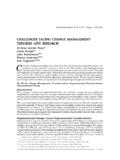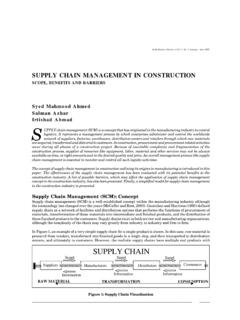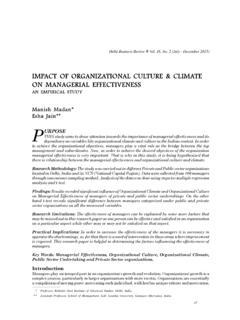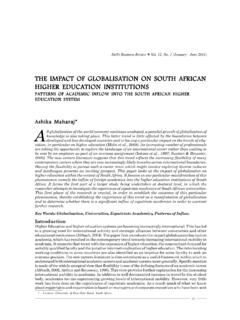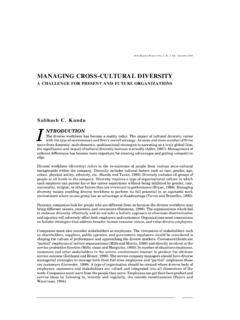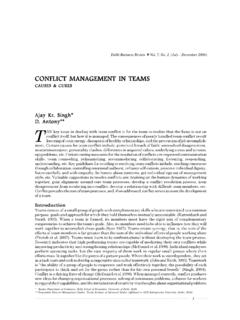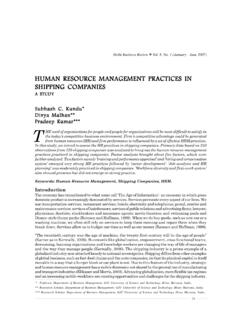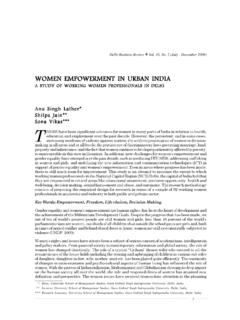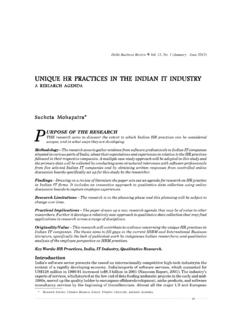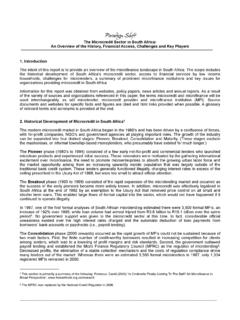Transcription of FINANCIAL PERFORMANCE OF MICROFINANCE …
1 Delhi Business Review X Vol. 11, No. 2 (July - December 2010). FINANCIAL PERFORMANCE OF MICROFINANCE . institutions OF INDIA. A CROSS SECTIONAL STUDY. CROSS-SECTIONAL. Pankaj K. Agarwal*. Sinha**. F. OR a country like India, poverty remains to be one of the biggest policy concerns. Amongst various measures to eradicate it, MICROFINANCE , of late, has provided a ray of hope. The Task Force on Supportive Policy and Regulatory Framework for MICROFINANCE constituted by NABARD. defined MICROFINANCE as the provision of thrift, saving, credit and FINANCIAL services and products of very small amount to the poor in rural, semi-urban and urban areas for enabling them to raise their income levels and improve their standard of living (Sen, 2008). In numerous studies done across the world, it is generally believed that various MICROFINANCE initia- tives have been able to make a difference in the target population's lives. However, increasing doubts have been raised over the FINANCIAL sustainability of MICROFINANCE institutions .
2 MFIs need to be eco- nomically viable and sustainable in the long run but economic implications of long term sustainability are not being considered (Srinivasan et al., 2006). At least in India, there does not seem to be any working model of analyzing the FINANCIAL PERFORMANCE and thereby sustainability of MICROFINANCE institutions . This problem is compounded by the absence of a dedicated legislation on working and management of MICROFINANCE institutions . The lack of a regulatory mechanism for FINANCIAL disclosures by MICROFINANCE institutions also abets the problem. The present study is an attempt to analyze the FINANCIAL PERFORMANCE of various MICROFINANCE institu- tions operating in India. It assumes significance because it is imperative that these institutions be run efficiently given the fact that they are users of marginal and scarce capital and the intended beneficia- ries are the marginalized sections of society. MFIs must be able to sustain themselves financially in order to continue pursuing their lofty objectives, through good FINANCIAL PERFORMANCE .
3 Key Words: MICROFINANCE , FINANCIAL Sustainability. Introduction Of late many government, businessmen and academicians alike have shown great interest in micro finance for its potential role in poverty alleviation activities. MICROFINANCE institutions have been ex- pected to reduce poverty , which is considered as the most important development objective (World Bank, 2000). Robinson defines MICROFINANCE as small-scale FINANCIAL services for both credits and depos- its that are provided to people who farm or fish or herd; operate small or micro enterprises where goods are produced, recycled, repaired or traded; provide services; work for wages or commissions; gain income from renting out small amounts of land, vehicles, draft animals, or machinery and tools; and to other individuals and local groups in developing countries, in both rural and urban areas (Robinson, 2001). Subsidized credit has long been believed to be the panacea for the eradication of poverty for decades * Research Fellow, XLRI, Jamshedpur, India.
4 ** Head, Department of FINANCIAL Studies, VBS Purvanchal University, Jaunpur, India. 37. Pankaj K. Agarwal and Sinha now. But perhaps the only thing subsidized credit could create was Non Performing Assets (NPAs). The realization that the core issue for the poor was access to credit rather than the cost of credit came very late. MICROFINANCE is often credited with putting an end to the interest rate debate for the poor. A host of players have entered MICROFINANCE space, each having a reason of its own. It is believed that, MICROFINANCE , unlike other developmental efforts, gives quick and tangible results (Srinivasan et al., 2006). Many NGOs that were early entrants gradually metamorphosed into full fledged lenders, devel- opmental professionals left their cushy careers to set up MICROFINANCE firms. Even many banks have experimented with working exclusively with self help groups and therefore have MICROFINANCE branches'. The players range from not-for profits organizations trying to achieve developmental objective through MICROFINANCE to commercial banks that view MICROFINANCE as good, sound banking', a good source of deposits, and low-risk mass lending.
5 In fact the success of self help groups in MICROFINANCE led many to use them to achieve many other objectives as well. Many governmental schemes are being routed through MICROFINANCE , including a very large project funded by the World Bank and being implemented in a southern state of India. Similarly organizations like Hindustan Lever has looked at the potential of these groups as a channel for retailing and has launched a program called Project Shakti' to tap the smaller villages through the micro-credit. They are also being harnessed as an alternative distribution channel. This amounts almost to free riding since these channels have been developed by the MFIs after a lot of persistent hard work and investment. The companies that initiated this are reputed ones like HLL, EID Parry and Philips etc. (Srinivasan et al., 2006). The persons engaged in championing MICROFINANCE are gaining prominence and it is said that some of the leaders, including many women, have been playing a more active role in other social spheres, to the extent of contesting elections for the panchayat and so on.
6 Conceptual Framework As MICROFINANCE firms are viewed predominantly as instruments of social change, their PERFORMANCE has been often measured by non- FINANCIAL parameters. The concept of social PERFORMANCE has seemed to overshadow the state of FINANCIAL health of these enterprises. However, the accepted criteria in a num- ber of studies to study the PERFORMANCE of any MFI have been the twain of FINANCIAL PERFORMANCE and Outreach (Chaves and Gonzales-Vega 1996, Ledgerwood 1999, Yaron, 1992, Yaron 1994, Yaron et al., 1998, as cited in Arsyad, 2005). However, there exist various social PERFORMANCE assessment tools and institutionalized rating processes but assessment of FINANCIAL PERFORMANCE has yet to gain ground. Some of the more popular tools include MFC Social Audit, ACCION SOCIAL, USAID SPA Audit, M- CRIL, Micro-finanza Rating, Micro Rate (SPA), CGAP-Grameen-Ford Progress out of poverty Index (PPI) etc. (Sen, 2008). These tools often focus on outreach indicators.
7 Outreach indicators are consid- ered as proxies for impact of MFI on development (Yaron el al., 1997). The FINANCIAL PERFORMANCE assessment is devoid of such a multitude of options and methodologies despite critical importance of FINANCIAL sustainability. Though an ambition for sustainable institutions has been often articulated, there was also an opinion that most MICROFINANCE institutions working in this field have been unsustainable (Copisarow, 2000 as cited in Dayson et al., 2006). Research studies have shown that this is predominantly connected to the perception of micro borrowers' risk and credit- worthiness, and the diseconomies of scale in making small loans (Quach, 2005, As cited in Dayson et al., 2006). MICROFINANCE has been attractive to lending agencies because of demonstrated sustainability and low cost of operations. In India, the engagement of NABARD and SIDBI shows that they see long term prospect for this sector (Srinivasan et al., 2006).
8 However, the methodologies to study FINANCIAL sustainability are fewer. Review of studies reveal that amongst those available, most of the tools available cover social as well as FINANCIAL PERFORMANCE . Principal among them are CAMEL model by ACCION, PEARLS model by WOCCU, GIRAFE Rating by PlaNet and MicroRate (CGAP, 2001 as cited in Arsyad, 2005). Amongst these, except the PEARLS. methodology by World Council of Credit Unions (WOCCU), all others are hybrid models using both qualitative and quantitative data (Arsyad, 2005). These methodologies are proprietary and not avail- able for use in public domain. 38. Delhi Business Review X Vol. 11, No. 2 (July - December 2010). It is noted with surprise that in India, a review of the studies done on MICROFINANCE sector has revealed that there is hardly any study focusing on the FINANCIAL health of MFIs. It seems this is due to the branding and common perception of MFIs as not for profit organizations. However the long term viability of any business model depends as much on the FINANCIAL viability as on its ability to deliver its avowed objectives.
9 It can be seen that without sound FINANCIAL PERFORMANCE the sustainability of these MICROFINANCE institu- tions is not possible. Increasingly questions are being raised over the cost of funds for these enterprises and their ability to earn margins sufficient to cover their operational costs and still leave some profit (Arsyad, 2005). It has been pointed out repeatedly that MFIs need to be economically viable and sus- tainable in the long run (Srinivasan et al., 2006). In fact studies have found strong linkage between the FINANCIAL sustainability of MICROFINANCE institutions and achievement of their social objectives. Low income customers are more likely to borrow from institutions they see as financially viable (Zeller et al., 2003). The extant business model of most of the MFIs involves huge operational costs since a lot of contact is required with the intended beneficiary. Also as for as the cost of funds are concerned, as the scale of operations goes up, MFIs need funds beyond the grant/soft loans etc.
10 The commercial funding requires them to have risk capital with market interest rates. In this backdrop the sustainability of MFIs needs to be looked at very carefully even from a social PERFORMANCE standpoint. The results achieved in poverty alleviation by MFIs can not be an event and given the endemic nature of poverty , requires a continuous and long term commitment from these enterprises. Morduch (1999) as cited by Crabb (2008), describes the need for more empirical work on the sustainability of MFIs. He points out: Empirical understandings of MICROFINANCE will also be aided by studies that quantify the roles of the various mechanisms in driving MICROFINANCE PERFORMANCE . The present study attempts to analyze and compare the FINANCIAL PERFORMANCE of the MFIs primarily from a sustainability standpoint. Data and Methodology Meyer (2002) indicated, Measuring FINANCIAL sustainability requires that MFIs maintain good finan- cial accounts and follow recognized accounting practices that provide full transparency for income, expenses, loan recovery, and potential losses.

